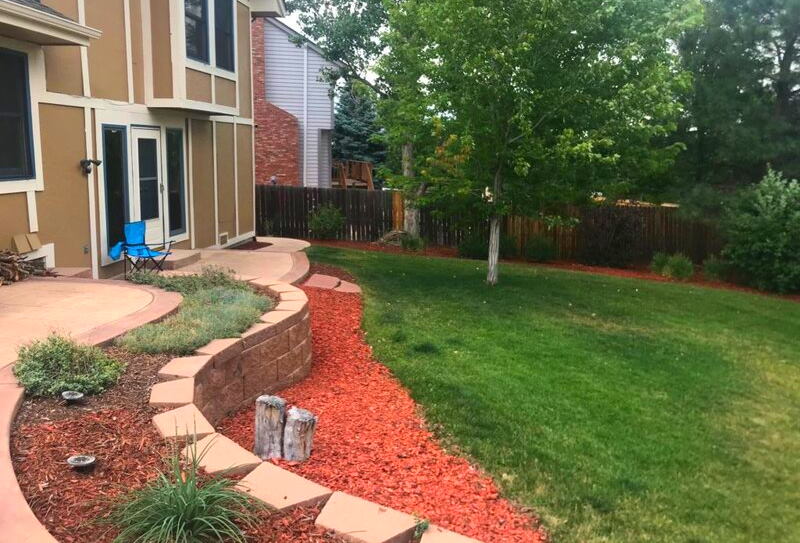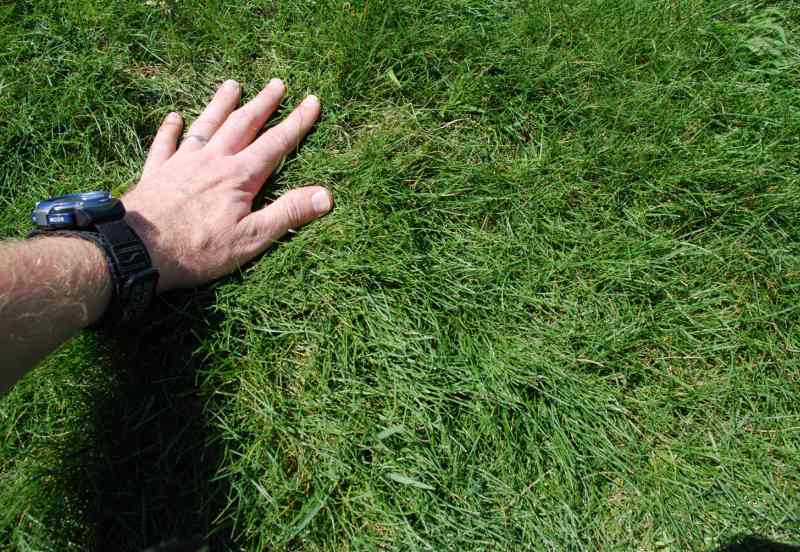3 Best Grass Seeds for Vermont
BY LASHONDA TUCKER | MAY 22ND, 2023 | LAWN CARE, VERMONTThe lawns at Shelburne Farms and Hubbard Park are lush and healthy. They are part of what makes the sites so alluring. You can have a home lawn with just as much beauty and appeal when you grow the right grass type. Keep reading to learn about the best grass seeds for Vermont.
It doesn’t matter if you’re in the Green Mountains area where the climate is colder and precipitation is high, the drier and hotter Champlain Valley region, or the Connecticut River Valley section of Vermont where it’s the driest. This article will help you choose the best grass seed to build your ideal lawn.
In this article:
- Warm-Season vs. Cool-Season Grasses
- 3 Grasses for Vermont
- FAQ About Vermont Grass Seeds
- Choosing Plant and Grass Varieties for Your Vermont Landscape
Warm-Season vs. Cool-Season Grasses
Whether you are overseeding or establishing a new lawn, there are two choices for grass seeds: warm-season grasses and cool-season grasses. Because Vermont has warm, mild summers and long, cold winters, cool-season grasses are the best type of grasses for The Green Mountain State.
Warm-season grasses thrive in hot, humid climates with mild winters. They grow best in the summer. This grass type goes dormant and turns brown during the cold winter months, from late autumn through early spring. This grass type is commonly found in the southern part of the United States.
Cool-season grasses perform well in areas where temperatures are cool throughout most of the year. Like warm-season grasses, cool-season grasses go dormant in freezing temperatures. However, cool-season grasses go dormant later in the winter than warm-season grasses.
Cool-season grasses also go brown and dormant in the summer as temperatures rise. They grow best in the spring and fall when the climate is cool. This grass type prefers air temperatures between 60 and 75 degrees Fahrenheit. Cool-season grass is commonly found in the northern regions of the United States.
3 Grasses for Vermont
Grass seeds selected for Vermont homes should be durable enough to withstand the state’s cold winters and warm summers. In addition to the snowy winters and the warm summers, Vermont’s weather conditions include floods, ice storms, and heat waves. While no grass can withstand all or even some of these environmental stressors, some grass types are better suited than others for the general Vermont climate. Let’s take a look at the three best cool-season grasses for Vermont.
1. Kentucky Bluegrass

Photo Credit: Brenda Ryan / Wikilawn
Kentucky Bluegrass has a medium texture and a dark, blue-green color that lives up to the grass’s name. It’s not the softest or the most coarse grass.
This grass is best for properties that get full sun and have well-drained soil. If your property contains a lot of trees blocking the sunlight, your yard is not the best environment for Kentucky Bluegrass to thrive. It has low shade tolerance.
Kentucky has more maintenance requirements than the other grasses on this list. It needs more fertilization and is more vulnerable to insects and diseases. Bluegrass also requires frequent mowing. This grass is better suited for homeowners with more time for lawn upkeep. However, it has its advantages.
If you have moderate physical activity on your lawn, bluegrass will hold up well. It recovers from foot damage quickly and has a moderate level of foot-traffic tolerance. Kentucky has a high cold tolerance, making it ideal for Vermont’s cold winters.
Mixing or blending bluegrass with other grasses that thrive best in Vermont will produce the healthiest lawn. Combining different grass species or varieties within grass species makes your lawn stronger and more adaptable to environmental conditions, resulting in a turfgrass canvas that better withstands pests and stress.
Classification: Cool-season grass
Spreads by: Rhizomes
Shade tolerance: Low
Drought tolerance: Moderate
Foot traffic tolerance: Moderate
Maintenance needs: Moderate mowing frequency and high fertilization needs.
Mowing height: Set mowing height between 2.5 and 3.5 inches.
Potential for disease: Moderate to high; prone to several diseases, such as dollar spot, leaf spot, necrotic ring spot, summer patch, and stripe smut.
Soil pH: 6-7.5
Soil type: Performs best in well-drained, heavy soils with high fertility.
Other notes: It needs more than 6 hours of full sun daily for optimal performance.
2. Fine Fescue

Photo Credit: Aaron Patton / Purdue’s Turfgrass Science Program
Fine fescue has a dark to medium green color. It comes with lower maintenance needs than Kentucky bluegrass and perennial ryegrass. If you don’t have much time for lawn chores or you prefer a low-maintenance turfgrass, fine fescue is the best option.
Because fine fescue does not spread by rhizomes like Kentucky does, but instead has a bunch-type growth pattern, fine fescue is not the best grass to fill in bare spots or dead spots. Kentucky or perennial is better suited if you have damaged spots.
Fine fescue’s growth pattern also makes it less traffic-tolerant than Kentucky bluegrass and perennial ryegrass. The fine fescue variety creeping red fescue spreads by rhizomes. However, the rhizomes are short, so creeping red fescue is treated like bunch-type grasses.
Despite its shortcomings, fine fescue does have its share of advantages. Since it grows slowly, it requires less mowing. It has lower fertilization needs than the other two grass types on this list, and it also adapts better to conditions that are less than optimal. For example, fine fescues tolerate multiple soil types and lower fertility.
This grass type is the most shade-tolerant of the cool-season grasses. It grows well in partial or full sun. So, whether your property has a lot of trees blocking the sun or your yard receives a lot of sunlight, fine fescue will adapt. It is important to keep in mind that although fine fescue tolerates a variety of soil types, it does not tolerate wet soil or poorly drained soil.
If you’re looking for a low-maintenance turfgrass, fine fescue is a good choice. On the other hand, if you have a lawn full of children playing after school and on the weekends, the low to moderate traffic tolerance of this type of grass rules it out as the best selection.
Classification: Cool-season grass
Spreads by: Creeping red fescue spreads by rhizomes, while other fine fescues are bunch-type grasses, such as chewing, hard, and sheep fescues.
Shade tolerance: Moderate to High, depending on species
Drought tolerance: Moderate to High, depending on species
Foot traffic tolerance: Low to Moderate, depending on species
Maintenance needs: Low fertilizer and mowing needs.
Mowing height: Set mowing height between 2.5 and 4.0 inches, depending on species.
Potential for disease: Moderate. Common diseases include red thread, leaf spot, dollar spot, summer patch, and powdery mildew.
Soil pH: 6-6.5
Soil type: Will not perform well in wet soil conditions. Prefers drier soils and tolerates a wide range of soil types and fertility.
Other notes: Sheep fescue, hard fescue, creeping red fescue, slender creeping red fescue, and chewings fescue are the most commonly used varieties.
3. Turftype Perennial Ryegrass

Photo Credit: Dr Mary Gillham Archive Project / Flickr / CC BY 2.0
Perennial ryegrass is a bunch-type grass. Like fine fescue, it does not recover well from high traffic. But unlike fine fescue, it has high foot-traffic tolerance. Perennial is a better grass for frequent lawn parties, although it will not recover from the damage as quickly as Kentucky bluegrass.
Perennial’s bunch-type growth pattern also makes it more susceptible to weeds. If you’re interested in using this grass type to remedy dead spots, you may find it interesting that the University of Vermont Extension Master Gardener reports that weeds tend to fill in bare spots before ryegrass can re-establish.
If you’re looking for a grass seed that establishes quickly, perennial is the optimal selection. It germinates in two to four days and produces a lawn in about 14 days. Most grass seeds do not germinate as quickly.
Perennial will not grow well in shady areas, so if your property does not get a lot of sun, stick to fine fescue varieties. Although it requires well-drained soil, very dry conditions will hinder its performance.
Perennial has a dark green color and fine texture. Its soft feel makes it great for toddlers that like to crawl on the grass or anyone who enjoys grounding themselves by walking barefoot.
Perennial is usually not planted alone, but in a mixture with Kentucky or fine fescues. Some reasons perennial ryegrass is best planted with other grass seeds are because of its vulnerability to pests and its lack of hardiness. It does not withstand stresses like heat, cold, salt, and drought.
Perennial grows aggressively and may suppress the growth of other grasses. Consequently, do not use more than 15 to 20% of it in grass seed mixtures.
Classification: Cool-season grass
Spreads by: Has a bunch-type growth habit
Shade tolerance: Low
Drought tolerance: Low
Foot traffic tolerance: High
Maintenance needs: Moderate mowing and fertilization requirements. Thatch is not significant.
Mowing height: Set mowing height to 1.5 to 2.5 inches
Potential for disease: High. Common diseases include gray leaf spot, red thread, and leaf spot/melting-out.
Soil pH: Can grow in soils with a pH between 5 and 8, but prefers between 6 and 7.
Soil type: Prefers good drainage and fertility, but can tolerate some poor drainage.
Other notes: It is recommended that Italian and Annual varieties be avoided. As seedlings, they can grow aggressively. Also, the cold winter weather causes them to die.
FAQ About Vermont Grass Seeds
The best time of year to plant grass seed in Vermont is during Labor Day. This gives the grass time to establish before winter. Do not plant later than the first week of September, as the grass needs about six to eight weeks to become well-established in cooler temperatures before the colder weather starts.
It depends on your expectations. Sodding allows you to establish grass faster. When you sod, you can do so at any time of year (as long as the soil isn’t frozen). Homeowners just need to make sure the grass will get sufficient water. However, sodding is expensive and there are not as many types of grasses to choose from for sodding.
Seeding, on the other hand, offers a larger variety of seeds to choose from. It is cheaper to seed, and the root system when you seed is initially stronger than when you sod. Unlike sodding, seeding is limited to the growing season, and it takes a longer time to establish a mature lawn when you seed.
Perennial ryegrass germinates the fastest, at two to four days.
Choosing Plant and Grass Varieties for Your Vermont Landscape
No one grass type is best suited for every condition. These conditions include the area of Vermont in which you reside, the characteristics of your property, and your lifestyle.
For example, a shady property requires grass with high shade tolerance. Even if Kentucky bluegrass is recommended for your region, you may need a grass type like fine fescue if your lawn barely gets any sunlight. You may want to be more specific, and choose the chewings variety, which is the most shade tolerant of the fine fescue grass species.
Choose grass that compliments your outdoor activity and availability to provide maintenance. A grass with children running and playing hide-n-seek needs durability to withstand the high foot traffic. If you want more time to enjoy sugar samples at the Morse Farm Maple Sugarworks, select grass seeds that free you from unnecessary upkeep.
Need the help of a lawn care pro? Hire a Vermont lawn care pro near you who will handle the yard’s mowing, trimming, and edging.
Main Photo Credit: The Park in Rochester / Kenneth C. Zirkel / Wikimedia Commons / CC BY-SA 4.0